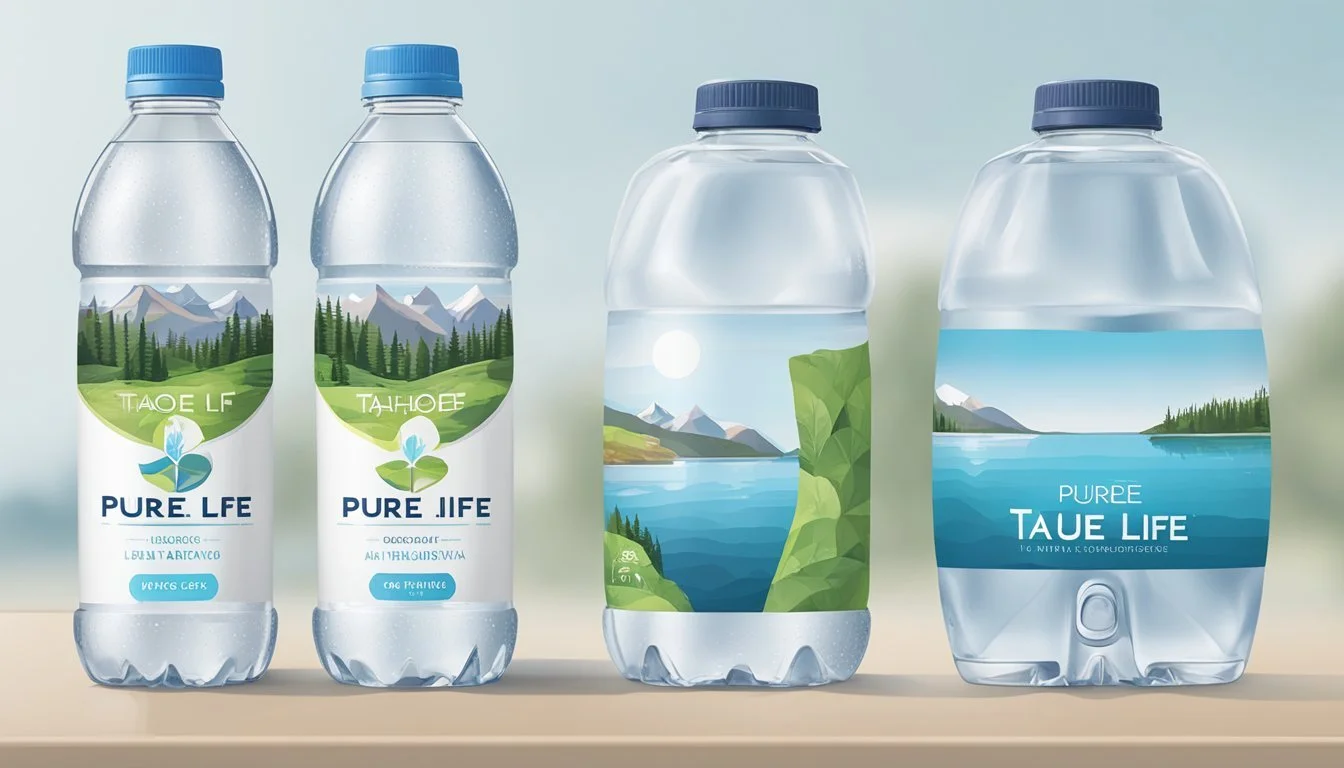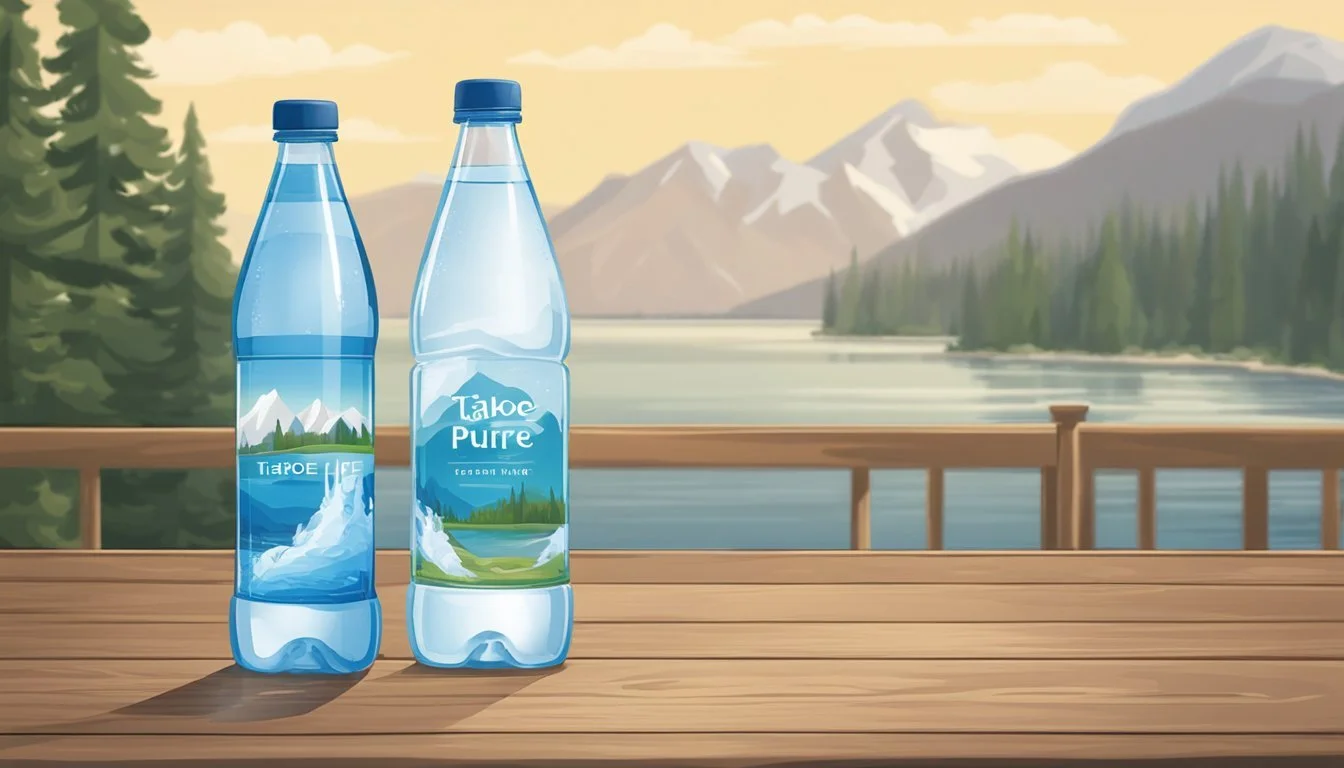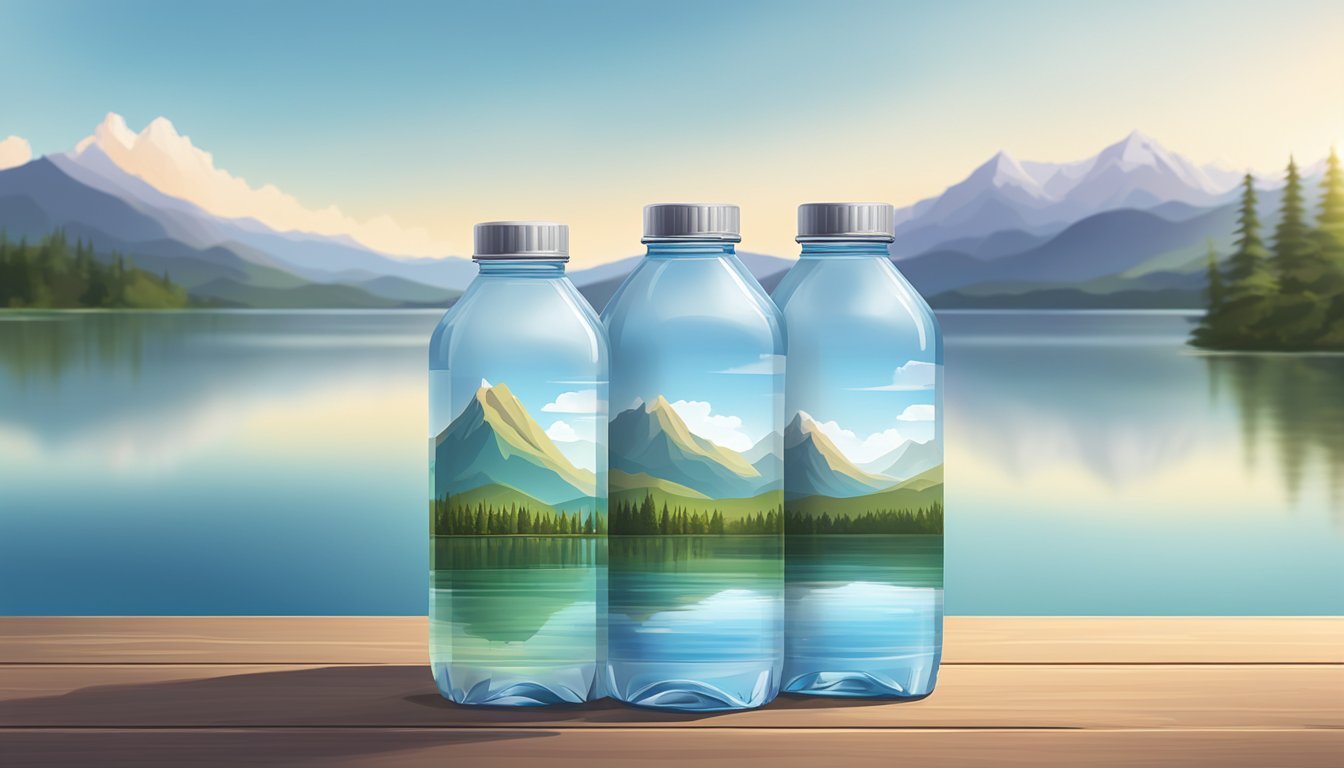Tahoe vs. Pure Life
Ultimate Bottled Water Comparison
Tahoe and Pure Life are two popular options in the crowded bottled water market; each brand boasts unique qualities that appeal to different preferences. Tahoe, known for its pristine mountain sources, often highlights its natural taste and high mineral content. In contrast, Pure Life, sourced from municipal and well water, focuses on providing an affordable and accessible option for everyday hydration.
For those prioritizing taste and natural purity, Tahoe edges out Pure Life with its clean, crisp flavor profile. While Pure Life's accessibility and cost-effectiveness make it a viable option for many, its chalky and metallic taste, as noted in various reviews, might not satisfy more discerning palates.
When considering health implications, both brands offer safe and reliable hydration. Yet, Tahoe's naturally-sourced mineral water may provide additional health benefits that are absent in Pure Life's filtered municipal water. Whether you're choosing for taste or health, understanding these differences will help you make an informed choice.
Understanding Bottled Water
Bottled water varies significantly based on its classification, source, mineral content, and brand reputation. Each element plays a crucial role in the final product that reaches consumers.
Classification of Bottled Water
Bottled water is categorized based on its source and treatment process. The main types include:
Spring Water: Derived from underground formations, naturally flowing to the surface.
Mineral Water: Contains a defined level of naturally occurring minerals.
Purified Water: Subjected to distillation, deionization, or reverse osmosis.
Artesian Water: Collected from a well tapping a confined aquifer.
Well Water: Drawn from a hole bored or drilled in the ground.
Different classifications impact taste, mineral content, and intended use.
Source and Origin
The source of bottled water significantly affects its characteristics and quality. Spring water and artesian water are valued for purity and natural mineral content since they naturally flow from protected underground sources.
Mineral water is sourced from mineral springs and retains minerals like calcium, magnesium, and sodium. Purified water is typically sourced from municipal supplies but undergoes treatments to remove impurities.
Well water varies in quality depending on the geographical region and local water conditions.
Minerals and Electrolytes
Minerals and electrolytes in bottled water contribute to taste and health benefits. Key electrolytes include:
Sodium: Essential for fluid balance.
Potassium: Important for muscle function.
Calcium: Necessary for bone health.
Magnesium: Supports metabolic functions.
Spring water and mineral water naturally contain these elements. Purified water may lack electrolytes unless they are reintroduced during processing.
Bottled Water Brands Overview
Several prominent brands dominate the bottled water market, each offering unique characteristics:
Nestlé Pure Life: Known for its purified water enhanced with a light blend of minerals for taste.
Zephyrhills: Natural spring water containing naturally occurring minerals.
Arrowhead: Provides spring and mountain water options, ranked in various industry tests.
Ozarka: Sources water from Texas springs, offering region-specific mineral profiles.
Brand reputation, source, and mineral content all contribute to consumer preference and market positioning.
Health and Hydration
For consumers choosing between Tahoe and Pure Life bottled water, evaluating hydration efficiency and health benefits is key. Differences in mineral content and purification processes impact hydration quality and nutritional value.
Hydration: Quality vs. Quantity
Hydration depends not just on drinking enough water, but also on the quality of the water consumed. Tahoe is a mineral water sourced from natural springs, known for its balanced mineral content. This often translates to better hydration, as minerals like magnesium and calcium aid in water absorption.
Pure Life, on the other hand, is a purified water that undergoes extensive filtration. While this ensures safety, it strips most natural minerals, making it less effective for optimal hydration compared to mineral-rich alternatives like Tahoe.
Key takeaway: Tahoe's natural minerals can enhance hydration compared to the purified composition of Pure Life.
Health Benefits of Mineral Contents
Mineral content plays a significant role in the health benefits of bottled water. Tahoe contains naturally occurring minerals such as calcium, magnesium, and potassium. These minerals contribute to various health benefits like bone strength, heart health, and muscle function.
Pure Life focuses on purity and is often lower in these beneficial minerals due to its rigorous purification process. While it is safe for consumption, the lack of minerals means fewer health benefits.
In summary, for those seeking bottled water that offers additional health advantages, Tahoe's mineral-rich profile may be preferable.
Dissecting the Contenders: Tahoe and Pure Life
Tahoe and Pure Life bottled water brands attract differing opinions, often due to factors like source, taste, and quality. This breakdown provides a detailed look at each brand and compares them head-to-head.
Tahoe Bottled Water Analysis
Tahoe bottled water is highly regarded for its origin, often sourced from pristine mountain springs. This natural source contributes to its pure, crisp taste, a factor that many consumers appreciate. The pH levels of Tahoe water are typically balanced, contributing to its neutral taste profile.
Quality control is stringent, with regular testing for contaminants and adherence to high standards. Consumers find Tahoe’s taste refreshing, free from the metallic or plastic flavors sometimes found in other brands. Tahoe's commitment to maintaining the integrity of its natural source is a significant selling point.
Pure Life Bottled Water Analysis
Pure Life, a widely recognized brand, sources its water from various municipal supplies across the United States. The water undergoes extensive purification, including reverse osmosis, and has minerals added back in for taste. This process ensures a consistent, clean taste regardless of the original source.
The pH levels of Pure Life water are carefully controlled to enhance taste and support hydration. While some critics argue that its municipal origins detract from its quality, the rigorous purification process restores consumer confidence. Pure Life remains popular for its affordability and availability.
Head-to-Head Comparison
Comparing Tahoe and Pure Life reveals several significant differences. Tahoe prides itself on sourcing water from natural springs, offering a fresher and more natural taste. Its balanced pH levels and stringent quality checks make it a favorite among those seeking authentic spring water.
Pure Life, contrastingly, is preferred for its consistent quality achieved through advanced purification. Its added minerals improve taste and hydration, though its tap water origins raise questions for some.
In taste tests, Tahoe often scores higher for its clean, natural profile while Pure Life appeals to those desiring a uniform, crisp taste. Ultimately, the choice depends on personal preference and priorities, such as the importance of natural sourcing versus purified consistency.
Filtration and Purification Processes
Different bottled water brands employ various filtration and purification methods to ensure the safety and quality of their products. These processes can include advanced techniques like reverse osmosis, natural filtration through springs and aquifers, and other sophisticated methods.
Reverse Osmosis
Reverse osmosis is a widely used method for purifying bottled water. This process forces water through a semipermeable membrane that removes contaminants and impurities. The membrane effectively filters out particles such as minerals and salts, resulting in virtually contaminant-free water.
One popular brand that utilizes reverse osmosis is Aquafina. This technique ensures high purity levels, making the water safe and clean to drink. Reverse osmosis also helps in eliminating bad tastes and odors, contributing to a better drinking experience.
Natural Filtration: Springs and Aquifers
Some bottled water comes from natural springs and aquifers, undergoing a natural filtration process as it seeps through layers of rock and soil. This natural filtration helps remove pollutants and adds beneficial minerals.
Brands like Nestlé Pure Life often source their water from natural springs. The water’s journey through underground aquifers provides a natural filtration system that imparts a crisp and clean taste. This process can help preserve the natural mineral content, enhancing the water’s flavor and health benefits.
Advanced Filtration Methods
In addition to reverse osmosis and natural filtration, brands use advanced filtration methods to ensure the highest quality. These can include carbon filtration, ultraviolet (UV) light treatment, and ozonation.
Carbon filters are effective at removing chlorine and organic chemicals, improving taste and smell. UV light treatment and ozonation are used to kill bacteria and viruses, offering an added layer of protection. For instance, the 12-step quality process of Nestlé Pure Life incorporates these advanced methods to ensure purity and taste consistency.
Both carbon filtration and UV light are essential in maintaining the integrity of bottled water, ensuring consumers receive a product that is both safe and enjoyable to drink.
Comparing Taste Profiles
When comparing the taste profiles of Tahoe and Pure Life bottled water, it is important to consider consumer preferences and the minerals in the water. These factors significantly influence the overall drinking experience.
Subjective Nature of Taste
Taste is inherently subjective, and water taste can vary significantly among individuals. Some people prefer a crisp, clean taste, while others might lean towards a more mineral-heavy flavor.
Tahoe water is often praised for its fresher, purer taste, attributed to its natural spring source. Many consumers find this water to offer a more refreshing experience.
On the other hand, Pure Life has received mixed reviews. Some consumers report a noticeable taste of plastic, possibly due to its packaging and source, which isn't as pristine as that of Tahoe. Ultimately, personal preference plays a crucial role in determining which brand one might favor.
Role of Minerals in Taste
The minerals present in bottled water significantly impact its taste. Tahoe water is naturally filtered through the mountains, picking up essential minerals like calcium and magnesium. These minerals contribute to its crisp and clean taste.
Pure Life, in contrast, undergoes a thorough purification process, and then minerals are reintroduced to enhance taste. However, the source being municipal water might affect the flavor profile negatively for some. Some consumers detect a metallic or chalky taste, likely from the added minerals.
In summary, the perceived taste of these waters is heavily influenced by mineral content and the purification process, affecting consumer preferences and satisfaction.
Environmental and Sustainability Concerns
The production and disposal of bottled water have significant environmental impacts. It's essential to scrutinize both the manufacturing process and the initiatives taken by companies to reduce their ecological footprint.
Bottling Process Impact
Bottled water production generally involves extracting water from sources, purifying it, bottling it, and distributing it. This entire process consumes substantial resources.
Water Usage: Extracting large volumes of water impacts local ecosystems.
Energy Consumption: Processing and bottling water use significant energy, increasing carbon emissions.
Plastic Waste: The primary environmental concern is plastic bottles, which contribute to waste if not recycled efficiently.
Tahoe and Pure Life both rely heavily on plastic packaging, raising concerns about the long-term environmental impact of their products.
Sustainability Initiatives by Brands
Tahoe and Pure Life have introduced initiatives aimed at mitigating their environmental footprint.
Tahoe: Focuses on reducing plastic usage by experimenting with plant-based bottles. It also invests in renewable energy for its bottling facilities.
Nestlé Pure Life: Promotes extensive recycling programs and uses recycled plastic in its bottles. The company engages in water conservation projects to preserve natural resources.
Both brands highlight their commitment to sustainability, but ongoing efforts are crucial for maintaining progress.
Consumer Choices and Impact
Consumers play a critical role in driving sustainability through their purchasing decisions.
Opting for brands with strong environmental credentials: Consumers can prioritize brands that use recycled materials and promote eco-friendly practices.
Participating in recycling programs: Proper disposal and recycling of bottles significantly reduce environmental waste.
Supporting initiatives: By choosing brands that invest in sustainable practices, consumers can encourage the industry to adopt more environmentally friendly approaches.
Understanding these factors helps in making informed choices that benefit the environment.
Market Presence and Consumer Demand
Tahoe and Pure Life are two significant players in the bottled water industry, each with distinct market strategies and consumer bases. Insights into their market presence reveal how consumer preferences shape the bottled water landscape.
Market Leaders and Innovators
Tahoe is recognized for its strong hold in specialty stores and select supermarkets. It often appeals to consumers looking for a premium, pure water experience. This brand emphasizes its high-quality natural sources and pristine taste, positioning itself as a premium option.
Pure Life, on the other hand, boasts a massive market presence with widespread availability across numerous grocery stores and retailers. As a brand under Nestlé Waters, it has a robust distribution network. Pure Life is known for affordability and has a reputation for consistency in taste and quality.
Changing Trends in Consumer Preferences
The bottled water industry has seen a marked shift as consumers increasingly prioritize health and wellness. With a growing demand for healthy alternatives, bottled water sales have significantly outpaced those of sugary soft drinks since 2016.
Consumers now favor products that are marketed as having additional health benefits, such as electrolyte-rich or alkaline water. Tahoe capitalizes on this trend by highlighting its purity and premium quality, appealing to health-conscious shoppers. Pure Life responds by offering value-packed options and maintaining wide accessibility, catering to a broad audience seeking everyday hydration solutions.
These trends illustrate the varying strategies of Tahoe and Pure Life in capturing market share and addressing evolving consumer demands.
Regulation and Safety Standards
Tahoe and Pure Life bottled water brands adhere to strict regulatory standards to ensure their products' safety and quality. These standards are primarily governed by the FDA, which oversees bottled water production and monitors for contaminants and purity.
FDA Regulations and Compliance
The U.S. Food and Drug Administration (FDA) imposes regulations on bottled water to ensure safety and quality. Both Tahoe and Pure Life must comply with these regulations.
These guidelines require bottled water to meet or exceed the safety standards of the Environmental Protection Agency (EPA), which governs municipal tap water. FDA regulations cover various aspects, including water sourcing, bottling processes, and labeling requirements. This compliance ensures that consumers receive water free from harmful contaminants.
Testing for Contaminants and Purity
To maintain safety and quality, Tahoe and Pure Life undergo rigorous testing for contaminants and purity.
The FDA mandates regular testing for numerous potential contaminants, such as bacteria, heavy metals, and chemicals. Each brand follows these stringent testing protocols to identify and eliminate any impurities in their water.
This ongoing testing and quality control process ensures that both Tahoe and Pure Life provide clean and safe drinking water, adhering to the highest standards set forth by the FDA.
Conclusion
Tahoe and Pure Life bottled waters offer distinct advantages and considerations for consumers.
Purity: Tahoe prides itself on being free from additives, drawing from natural sources. Pure Life, while also claiming purity, is enhanced with minerals for taste, which some may prefer.
Convenience: Both brands are widely available. However, Pure Life has a broader distribution, making it easier to find in stores.
Ethical Considerations: Consumers increasingly value the environmental impact of bottled water. Tahoe's smaller production may imply lower environmental impact, while Pure Life, as part of Nestlé, faces criticism over resource extraction and plastic usage.
Tap Water Comparison: Bottled water is often compared to tap water for cost and environmental reasons. Both Tahoe and Pure Life offer a sense of bottled purity and convenience that tap water might lack, particularly in areas with poor water quality.
Taste:
Tahoe: Crisp and clean, favored for its straightforward, natural taste.
Pure Life: Enhanced with minerals, offering a slightly different flavor profile.
Ultimately, the choice between Tahoe and Pure Life depends on individual preferences for purity, convenience, taste, and ethical considerations. Both serve as reliable options in the bottled water market.
More About Tahoe
Mountain Valley Spring Water vs Tahoe: Which Bottled Water is Better?
Tahoe vs Richard's Rainwater: Which Bottled Water is Better?
Tahoe vs Whole Foods Italian Still Mineral water: Which Bottled Water is Better?
More About Pure Life
Cascade Mountain vs Pure Life: Which Bottled Water is Better?
Hawaii Volcanic vs Pure Life: Which Bottled Water is Better?
Hawaiian Springs vs Pure Life: Which Bottled Water is Better?
Icelandic Glacial vs Pure Life: Which Bottled Water is Better?
Nestle Pure Life vs Pure Life: Which Bottled Water is Better?
Pure Life vs Kirkland Signature: Which Bottled Water is Better?
Pure Life vs Whole Foods 365: Which Bottled Water is Better?
Richard's Rainwater vs Pure Life: Which Bottled Water is Better?
Solan de Cabras vs Pure Life: Which Bottled Water is Better?
Talking Rain AQA vs Pure Life: Which Bottled Water is Better?










